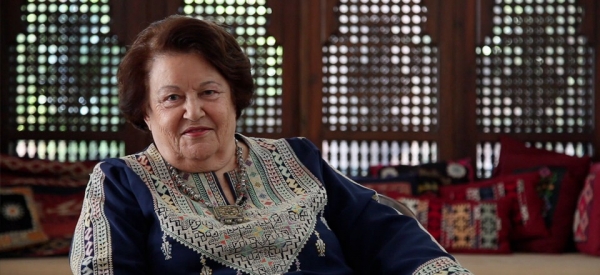As a wedding present, Mrs Kawar was given several embroidered dresses and this was to encourage a lifelong interest in her own Palestinian heritage coupled with that of Jordan, via the clothing and dress accessories worn by men, women and children. The Arab-Israeli War of 1948 had a profound effect on Mrs Kawar and she was extra motivated to collect material and non-material cultural heritage of the region in order to preserve it for the future.
After the war of 1967 she increased her activities with respect to preserving and documenting costume and embroidery heritage. Over the years the Widad Kawar Collection has grown to become the largest collection of Palestinian and Jordanian dress in the world. In addition, her collection includes items from neighbouring countries, including Egypt, Lebanon, Saudi Arabia, Syria, Turkey, as well as Yemen. At the same time she encouraged and supported craftsmen and women by acquiring their items, and establishing outlets where garments could be purchased.
In 2012 Widad Kawar was awarded the Prins Claus Award (Netherlands) for her work in documenting and preserving Palestinian cultural heritage.
In 2014 the Tiraz: Widad Kawar Home for Arab Dress was opened to the general public, in a building next door to Mrs Kawar’s private home. Tiraz includes all of the items from the Widad Kawar dress and textile collection.
Over the years she has produced or participated in a number of books and articles about the subject of Palestinian culture, dress and in particular the role of embroidery in the lives of many women. These works include:
- KAWAR, Widad (1980). Weaving in Jordan, with Marian Awwad, Jordan Crafts Council.
- KAWAR, Widad (1982). Costumes Dyed by the Sun: Palestinian Arab National Costumes, Tokyo: Bunka Publishing Bureau.
- KAWAR, Widad (2011). Threads of Identity: Preserving Palestinian Costume and Heritage, Nicosia: Rimal Publications
- KAWAR, Widad and Tania NASIR (1992). Palestinian Embroidery: Traditional "Fallahi" Cross-Stitch, Beirut: Institute of Publishing.
- KAWAR, Widad and Sibba EINARSDÓTTIR, Sybbe (2010). ‘Palestinian women’s dress', Berg Encyclopedia of World Dress and Fashion, Oxford: Berg Publishers, vol. 5, pp. 173-182.
- SKINNER, Margarita (2007). Palestinian Embroidery Motifs, A Treasury of Stitches 1850-1950, Melisende Publishing, London and Rimal Publications, Nicosia.
- VOGELSANG, Gillian (ed., 2016). Encyclopedia of Embroidery from the Arab World, London: Bloomsbury.
- VÖGLER, Gisela, Karin v. WELCK and Katharina HACKSTEIN (eds; 1987). Pracht und Geheimnis: Kleidung und Schmuck aus Palästina und Jordanien, Cologne: Rautenstrauch-Joest-Museum der Stadt Köln.
GVE

